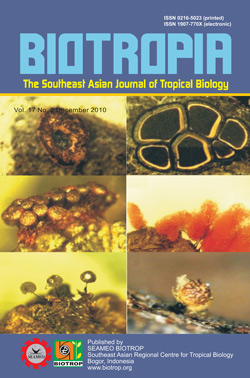
Tags
ECOLOGICAL STUDY IN TWO QUARRIED LIMESTONE KARST HILLS IN BOGOR WEST JAVA: VEGETATION STRUCTURE AND FLORISTIC COMPOSITION
Content Language : English

Many species extinctions have probably gone unnoticed on limestone that was destroyed before they could be sampled. Unless biodiversity surveys are intensified, the true magnitude of extinctions will never be ascertained. The objectives of this study were to determine tree species composition of limestone hills in Nyungcung and Ciampea; to determine quantitatively the dominant and less dominant species and to quantify floristic structure of the two limestone hills. Value of richness (Menhinick) and evenness in Nyungcung were 3.28 and 0.826 whilst in Ciampea were 3.29 and 0.823, respectively. In term of diversity (Shannon Wiener), Nyungcung seems to be more diverse than Ciampea as indicated by the higher value of diversity index. Nyungcung has 3.225 of diversity (Shannon Wiener) index while Ciampea has 2.859. The floristic composition of two sites was significantly different and mostly comprised Moraceae, Rubiaceae, and Euphorbiaceae. However, the highest presence of species were Antidesma montanum (Euphorbiaceae) and Chrysophyllum lanceolatum (Sapotaceae), and Pandanus sp. (Pandanaceae) in Nyungcung, whereas in Ciampea, Harpullia arborea (Sapindaceae), Ophiorhhiza canescens (Rubiaceae), and Allophyllus cobbe (Sapindaceae). Macaranga rhizinoides, O. canescens, A. montanum, and Turpinia montana , respectively , gained the highest importance values.
Link

This work is licensed under a Creative Commons Attribution-NonCommercial-NoDerivatives 4.0 International License.
